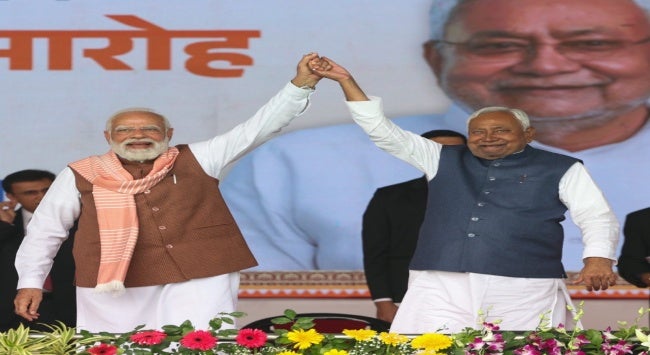Summary
Nitish Kumar is once again Bihar’s chief minister after the National Democratic Alliance (NDA) swept to victory. The composition of the new cabinet in Bihar reflects a balancing act between the two major NDA partners – Janata Dal (United) and the Bharatiya Janata Party – and caste considerations.
Nitish Kumar was sworn in as chief minister of Bihar for a record 10th time on 20 November 2025 after the National Democratic Alliance’s (NDA) sweeping victory in the Bihar Assembly election. The two main constituents of the NDA – Nitish’s Janata Dal (United) [JD(U)] and the Bharatiya Janata Party (BJP) – won 85 and 89 seats respectively of the coalition’s 202 seats in the 243-seat Assembly.
The Bihar result signalled the continuing dominance of the NDA in the period following the 2024 general election where the BJP had underperformed. Since the general election, the NDA has achieved sweeping victories in Haryana, Maharashtra, New Delhi and now Bihar. The Bihar victory will buoy the BJP before the 2026 Assembly election in West Bengal – a state that has remained outside the BJP’s grip. The Bihar verdict was yet another blow for the Congress, which has suffered one reverse after another since the general election, and a huge setback for the Tejashwi Yadav-led Rashtriya Janata Dal (RJD). Another facet of the result was the fracturing of the Muslim vote. Of the 11 Muslims elected in Bihar, five are from the All India Majlis-E-Ittehadul Muslimeen, three from the RJD, two from the Congress and one from the JD(U).
While the seat tally of the NDA is remarkable by any measure, the coalition built on its gains in the general election where its vote share was nearly eight per cent more than the rival Mahaghatbandhan, comprising the RJD, Congress and other smaller parties. In the Assembly election, the gap widened by a further one per cent. As many analysts had argued before the election, the Extremely Backward Classes (EBC) vote proved critical to the NDA’s victory.
A notable feature of the election was the continued success of Nitish who, at 74 years, has been showing signs of age and infirmity in public. He has also switched political affiliations regularly to stay in power. However, his political opportunism, as well as the poor state of Bihar’s economy, does not seem to have affected his efficacy or popularity as he led the JD(U) to double its seat tally from 2020 when the party won 43 seats. Indeed, this was the JD(U)’s best results in Bihar since 2010. Part of the reason for Nitish’s success, despite belonging to the numerically small Kurmi community, has been his ability to stitch together a coalition of the less dominant groups, particularly the EBCs and women.
Hence, it was not surprising that Nitish was appointed Bihar’s chief minister despite the BJP being the largest party in terms of seats. It might be noted that Nitish has had multiple spells as Bihar’s chief minister for a little over 19 years unlike long-serving chief ministers, such as Jyoti Basu, Naveen Patnaik and Pawan Chamling, who have had a continuous tenure of 23 years or more. If Nitish completes his current five-year term though he will be among the longest-serving chief ministers in India.
The composition of the new cabinet in Bihar reflects a balancing act between the two major NDA partners – the BJP and the JD(U). Of the 26 ministers sworn in along with Nitish, 14 are from the BJP and eight from the JD(U). Samrat Chaudhary and Vijay Kumar Sinha from the BJP have been reappointed as deputy chef ministers. Of the smaller parties in the coalition, two ministers have been appointed from the Lok Janshakti Party (Ram Vilas) [LJP(RV)], and one each from Hindustani Awam Morcha (Secular) and Rashtriya Lok Morcha.
Caste considerations have also been kept in mind in the cabinet formation. Eight members in the cabinet are from the upper castes, six each from the Other Backward Classes (OBCs) and the EBCs and five from the Scheduled Castes (SCs). Of the upper castes, Brahmins, Rajputs, Bhumihar and Kayastha were represented in the cabinet. Among the OBCs, Kushwahas, Kurmis and Yadavs received cabinet berths while the EBCs’ cabinet positions were spread across the Kahar, Mallah, Teli, Nishad, Dhanuk and Sudhi communities. Of the SCs, the Paasi, Mushar, Paswan and Ravidas communities found place in the cabinet. There was a nod for the women who voted in large numbers for the NDA with three women representatives in the cabinet. Only one Muslim – Mohammad Zama Khan of the JD(U) – found a place in the cabinet.
There are nine new faces in the cabinet, including the LJP(RV)’s Sanjay Kumar Singh, who defeated RJD leader Lalu Prasad’s son, Tej Pratap Yadav, in the Mahua constituency. One surprising omission though was JD(U)’s Nitish Mishra, who, as Industries Minister, was considered a key member in the earlier Cabinet in attracting investment to Bihar.
. . . . .
Dr Ronojoy Sen is a Senior Research Fellow and Research Lead (Politics, Society and Governance) at the Institute of South Asian Studies (ISAS), an autonomous research institute at the National University of Singapore (NUS). He can be contacted at isasrs@nus.edu.sg. The author bears full responsibility for the facts cited and opinions expressed in this paper.
-
 More From :
More From :
-
 Tags :
Tags :
-
 Download PDF
Download PDF



